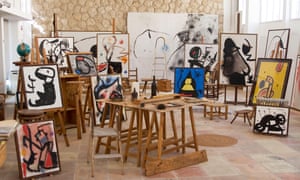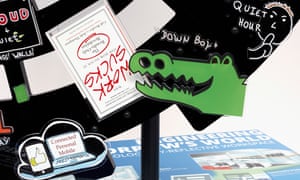
When the studio where the Spanish artist Joan Miró lived and worked until his death in 1983 is recreated in the dank darkness of midwinter London, some elements will be missing. The most important is the dazzling Mallorcan light, streaming in through huge windows, bouncing off the steep slope above and the sea far below. Another is the mummified cat hanging on a wall.
The Mayoral brothers, Eduard and Jordi, founded their gallery in Barcelona seven years ago to showcase artists linked to their city, including Miró, who was born there in 1893.
They dreamed up their most ambitious project to reveal something crucial to the artist’s later work, the purpose-built studio in Mallorca , where Miró worked longest and most productively.
The studio’s interior was originally tailor-made for Miró by his friend the architect Josep Lluís Sert via voluminous correspondence from the US where Sert was a Harvard professor at the time.
It is now being recreated through photographs taken in the 1970s by Jean-Marie del Moral, one of the few outsiders trusted to record it, and the memories of the artist’s grandson, the author and art historian Joan Punyet Miró.
Jordi Mayoral said: “We wanted to find a way to make people feel the space, but we hope they will then go to experience the real place in Mallorca.”
The studio’s original contents, including a pair of overalls splashed with bright yellow paint – instantly recognisable to any lover of Miró’s work – cannot move. Instead the Mayoral brothers are collecting replicas and will reproduce the paint-spattered canvas serving as a rug, and are trying to find someone to weave a copy of the sinister palm leaf sun-face that hangs from the ceiling, identical to one owned byPicasso.
The brothers will also include original correspondence and 25 paintings and drawings. The issue of how to recreate the double-height rock wall, like something from an archaeology site, is still being debated – Miró, said Punyet Miró, believed art had been going downhill since the cave men.
Two years before his death, Miró fell on the ladder-like stairs connecting the house where his grandson now lives and the studio. He left the beautiful white building and the old house next door, bought when he needed more space, and went to the capital, Palma.
The site, which includes a handsome gallery added after his death, is now a museum filled with deeply personal contents, including half-finished paintings still on their easels or stacked against the walls , comfortable country chairs where he sat contemplating work often left unfinished for years, paint tubes and brushes propped in teacups, toys, local ceramics, and the pebbles and twigs that came back in his pockets from long walks in the surrounding countryside.
Punyet Miró said: “He could make a painting in 10 seconds, but for this 10 seconds, he had thought for a year.”
His grandson recalls the first time he was invited into the studio, on his 10th birthday. “I remember it exactly, the smell of turpentine and linseed oil, of oil paint and acrylic paints, and hundreds and hundreds of works everywhere. I knew, of course, my grandfather was an artist, but after that I was in awe of him.”
Mallorca was the home of Miró’s grandparents, and of his wife, Pilar. He took his family there first to escape the second world war, and then in 1954 bought the house on a steep hillside on the outskirts of Palma.
In 1938, Miró wrote a poignant essay, I Dream of a Large Studio, recalling his early poverty in Paris – “because I was very poor, I could only afford one lunch a week: the other days I settled for dried figs and chewing gum” – and his many cramped and borrowed studios. At the Rue Blomet he painted The Farm, which he sold to Ernest Hemingway, a friend and occasional sparring partner, who dwarfed Miró in unequal combat, and Head of the Spanish Dancer, which went to his friend, Picasso.
Of the studio on Rue Blomet, he wrote: “The windows were broken, and my stove, which cost me 45 francs at the flea market, didn’t work. But the studio was very clean. I did the housework myself.”
When the artist finally acquired his dream studio, it transformed his life and his work, said Punyet Miró. Despite the photographs of an apparently gentle old man, according to his grandson, Miró was a savage, a wolf. He remembers watching his grandfather drawing with such pressure that the pencil snapped.
As Punyet Miró led the way to the second studio, the neighbouring 18th-century stone house that Miró bought in 1959 for more space and more privacy, the museum’s skinny black cat ran over to greet him, twining around his ankles. “This is not a good place for cats,” he said, stooping to pull its ears, “Come, I will tell you a terrible story.”
His grandfather had just such a cat, which liked to follow him into the studio and sit watching him work. One day Miró accidentally locked the cat behind the massive olive wood door and left – for a six-month work tour. The mummified corpse, mouth gaping in a silent yowl of anguish, which he found on his return, still hangs on the wall.
“Terrible, no?” Punyet Miró said, lifting it down and swinging it cheerfully. “You or I, we would throw this horrible thing out in the rubbish. But he kept it – the honesty of life and death, that’s what it meant to him.
“This, to me, is one of the most important places in Mallorca, in Spain, in the world.”
• Miró’s studio, Mayoral will be at 6 Duke Street, London, from 21 January to 12 February 2016












